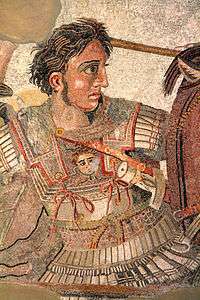Pteruges
Pteruges (also spelled pteryges, from Greek πτέρυγες, meaning "feathers") refers to strip-like defences for the upper parts of limbs attached to armor in the Greco-Roman world.

Appearance and variation
Pteruges formed a defensive skirt of leather or multi-layered fabric (linen) strips or lappets worn dependant from the waists of Roman and Greek cuirasses of warriors and soldiers, defending the hips and thighs. Similar defenses, epaulette-like strips, were worn on the shoulders, protecting the upper arms. Both sets of strips are usually interpreted as belonging to a single garment worn under a cuirass, though in a linen cuirass (linothorax) they may have been integral. The cuirass itself could be variously constructed: of plate-bronze (muscle cuirass), linothorax, scale, lamellar or mail. Pteruges could be arranged as a single row of longer strips or in two or more layers of shorter, overlapping lappets of graduated length.[1]
Possible later use
During the Middle Ages, especially in the Byzantine Empire and in the Middle East, such strips are depicted depending from the back and sides of helmets, to protect the neck while leaving it reasonably free to move. However, no archaeological remains of leather strip defences for helmets have been found. Artistic depictions of such strip-like elements can also be interpreted as vertically-stitched quilted textile defences.[2]
 Pteruges of leather on the back of a reconstruction of a Byzantine helmet
Pteruges of leather on the back of a reconstruction of a Byzantine helmet Pteruge featuring the face of Jupiter-Amon at the Musée des beaux-arts de Lyon
Pteruge featuring the face of Jupiter-Amon at the Musée des beaux-arts de Lyon
See also
References
- Aldrete et al., cited throughout
- Dawson, Timothy: Byzantine Infantryman, Oxford (2007), pp. 20–21
Bibliography
- Gregory S. Aldrete; Scott Bartell; Alicia Aldrete. (2013). Ancient linen body armor : unraveling the linothorax mystery. Baltimore: Johns Hopkins University Press. ISBN 9781421408194.
- Dawson, Timothy (2007). Byzantine Infantryman. Eastern Roman Empire c.900–1204. Osprey. ISBN 978-1-84603-105-2.